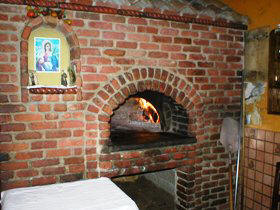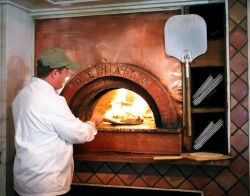masonry oven

A masonry oven, also known as a brick oven, is an oven consisting of a baking chamber made of fireproof brick, concrete, stone, or clay. Though traditionally wood-fired, coal-fired ovens were common in the 19th century and modern masonry ovens are often fired with natural gas or even electricity. Modern masonry ovens are closely associated with artisan bread and pizza, but in the past they were used for any cooking task involving baking.
The traditional direct-fired masonry design is often called a "Roman" or "black" oven and dates in Western culture to at least the Roman Republic. It is known as a black oven due to the fact that the smoke from the wood used as fuel sometimes collects as soot on the roof of the oven. Such ovens were in wide use throughout medieval Europe and were often built to serve entire communities (cf the banal ovens of France, which were often owned by the local government and whose operators charged a fee to oven users). Such ovens became popular in the Americas during the colonial era and are still in wide use in artisan bakeries and pizzerias, as well as some restaurants featuring pizzas and baked dishes. Descendants include the beehive ovens of the colonial United States and the Quebec ovens based on the designs of the banal ovens of France.
Wood-burning masonry ovens are considered an integral component to the production of true Neapolitan pizza.
Design and construction
 |
The function of a masonry oven is to trap and radiate heat from a fire, either built within the oven itself (a black or Roman oven, as described above) or in a firebox that vents into the oven (a white oven); smoke is vented through the front of the oven, either directly to the outside or through a chimney immediately above the oven door. The front-loading masonry design is generally held to be somewhat more heat-efficient than an open-topped oven like a tandoor.
Masonry ovens are generally built with fire-resistant materials like firebrick or clay. Those designed for bread use are generally quite heavily built to store several hours' worth of heat after completely burning a load of wood, while those designed for pizza or other live-fire cooking techniques can have thinner construction. Generally, a properly-built Roman-plan oven is roughly egg-shaped, with the ceiling of the oven constructed as an arch over the baking surface. The front entrance is ideally approximately 63�5% the height of the top of the oven ceiling; too high and heat is lost, too low and the oven does not heat completely.
The "white oven" is a somewhat more complex design that pipes heat in from an external firebox without routing the smoke from the fire through the oven. A compromise design known as the gueulard in France combines aspects of both internal and external-fired models.
Modern-designed masonry ovens sometimes bear little resemblance to their forbears, sometimes having only a refractory cement deck inside a more conventional oven exterior.
